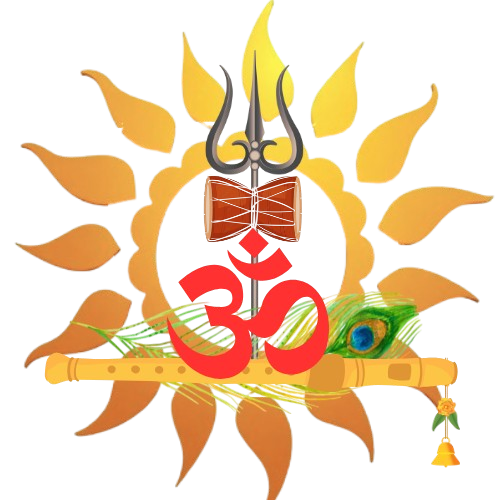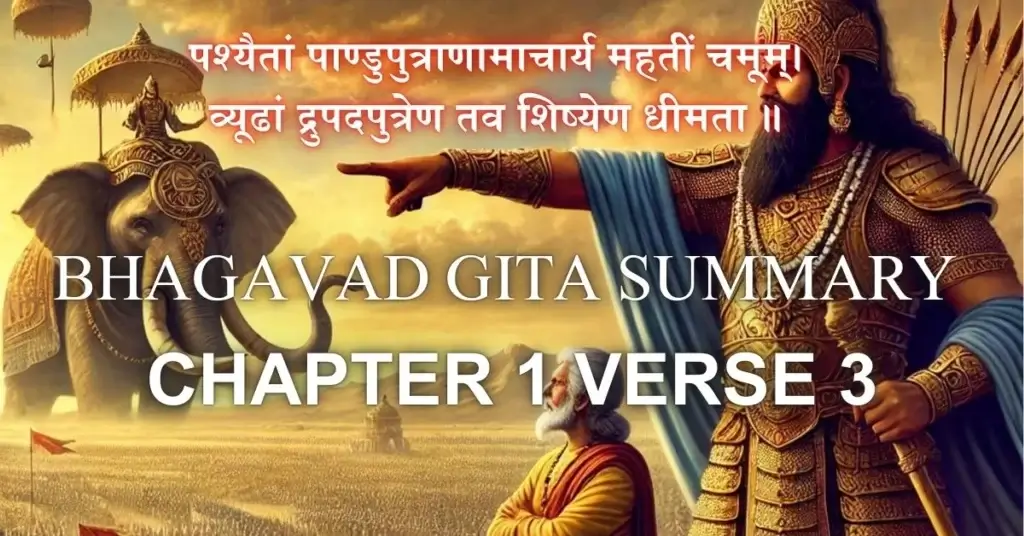Translation of Bhagavad Gita Shloka Verse 1.3 in English:
पश्यैतां पाण्डुपुत्राणामाचार्य महतीं चमूम्।
व्यूढां द्रुपदपुत्रेण तव शिष्येण धीमता ॥3॥
In English :
Paśyaitāṁ Pāṇḍu-putrāṇām Ācārya Mahatīṁ Camūm
Vyūḍhāṁ Drupada-putreṇa Tava Śiṣyeṇa Dhīmatā
Full Line-by-Line Phonetic Breakdown of Bhagavad Gita Chapter 1 Verse 3:
- Paśyaitāṁ Pāṇḍu-putrāṇām Ācārya Mahatīṁ Camūm
- Pash-yai-taam Paan-du-put-raa-naam Aa-cha-rya Ma-ha-teem Cha-moom
- Vyūḍhāṁ Drupada-putreṇa Tava Śiṣyeṇa Dhīmatā
- Vyoo-dhaam Dru-pa-da-put-ray-na Ta-va Shi-shyai-na Dhee-ma-taa
“O Acharya! Look at this huge army of the sons of Pandu, which has been organized and raised by your intelligent disciple, the son of Drupada (Dhrishadyumna).”
Lets Understand the Bhagavad Gita Summary 1.3 in English:
In this verse, Duryodhana is speaking to his guru, Dronacharya, on the battlefield of Kurukshetra. He points towards the massive and well-organized army of the Pandavas, He specifically highlights that their battle formation has been skillfully arranged by none other than Drupada’s son, Dhrishtadyumna—who ironically was once DronAcharya’s own student. This remark delicately reminds Dronacharya of past conflicts, as Dhrishtadyumna was born with the divine purpose of defeating him. Through this, Duryodhana aims to ignite emotions in his guru, perhaps hoping to fuel his determination for battle.
Context of Bhagavad Gita Chapter 1: The Stage for the Kurukshetra War
The first chapter of the Bhagavad Gita, named as “Arjuna Vishada Yoga” (The Yoga of Arjuna’s Misery), paints a vivid picture of the battlefield at Kurukshetra. Here, two mighty armies stand prepared for war—the Kauravas and the Pandavas. Each side is driven by deep-seated motivations, alliances, and personal quests for victory.
Duryodhana, the leader of the Kauravas, surveys his army and notices its strengths and weaknesses. His observations, conveyed in Bhagavad Gita Chapter 1 Verse 3, reflect the importance of leadership, strategy, and morale. Discussing the Bhagavad Gita Summary 1.3 ,we can notice how Duryodhana sees his army’s formidable power under Bhishma, one of the greatest warriors of his time.

Verse 1.3 – The Echo of Karmic Ties and Inner Battles
This single verse from the Bhagavad Gita is a brilliant reflection of human psychology, destiny, duty, and divine play. In this journey of grasping the summary of the Bhagavad Gita 1.3 teaches us that life’s greatest battles are not just fought with weapons but with emotions, choices, and inner conflicts. Whether viewed as a political move, a psychological tactic, a historical moment, or a spiritual lesson, this verse remains deeply relevant even today. Let’s begin…
Verse Breakdown: Understanding the Depth of Bhagavad Gita Chapter 1 Verse 3
To better understand the summary of Bhagavad Gita 1.3, let’s break it down into its core elements:
This verse is spoken by Duryodhana to Dronacharya at the beginning of the Kurukshetra war. Duryodhana, the prince of the Kauravas, approaches his teacher Dronacharya and points out the well-organized military formation of the Pandavas, led by Dhrishtadyumna, the son of King Drupada.
- “O Teacher (Acharya), behold this great army of the Pandavas” – Duryodhana tries to alert Dronacharya about the strength of the Pandava army. He is somewhat anxious and wants to ensure that his own army is fully prepared.
- “Arranged by the son of Drupada (Dhrishtadyumna)” – Dhrishtadyumna, who was born to kill Dronacharya, has skillfully arranged the battle formation. Duryodhana subtly reminds Dronacharya of this fact, perhaps to provoke him into fighting more aggressively.
- “Your wise disciple” – There is a tone of irony in Duryodhana’s words. He emphasizes that the person leading the Pandava army was once trained by Dronacharya himself. This could be an attempt to stir emotions in Dronacharya and make him fight harder against the Pandavas.
Psychological State of Duryodhana : Arjuna’s Dilemma
Perception and Fear of Duryodhana: Duryodhana’s observation reflects his inner anxiety and insecurity. Though he boasts about the strength of his own army, his focus on the Pandava army’s arrangement reveals his underlying fear of opposition. Psychologically, Bhagavad Gita 1.3 can teach us that:
- Acknowledging others’ abilities can be a sign of self-awareness, but overly focusing on them can paralyze us.
- Fear and insecurity often arise when we perceive others’ strengths as a threat.
Comparison with Arjuna’s Perspective
- Unlike Duryodhana, Arjuna faces an internal battle of morality and duty.
- This contrast between ego-driven confidence and self-doubt enriches the Gita’s teachings.
Philosophical Insights on the Battle Between Dharma and Adharma
In this journey of understanding the Summary of the Bhagavad Gita 1.3, we can notice this verse from the Mahabharata symbolizes the eternal conflict between Dharma (righteousness) and Adharma (ego-driven desires).
- Duryodhana represents human arrogance, seeking strength in external power rather than inner wisdom.
- His reliance on Dronacharya reflects how people often look to external sources for validation instead of introspection.
The Illusion of External Strength
- Many believe material success and authority define true power, but real strength lies in righteousness.
- The Bhagavad Gita teaches that Adharma may seem strong, but it ultimately leads to downfall.
- Without Dharma, even the greatest warriors fall, as seen in the fate of Duryodhana.
Seeking Inner Wisdom Over External Guidance
- Instead of blindly following external figures, one must seek self-awareness and moral clarity.
- Krishna teaches Arjuna that inner wisdom is the highest form of strength.
“According to Krishna, we are given the right to carry out our acts (karma), even though we are powerless over everything. Karma, or our deeds, are what we can control in the equation of karma, deva (destiny), kala (time), and Phala (outcome).”
Bhagavad Gita Chapter 1 Verse 3: A Historical Perspective on Betrayal, Fate, and Karmic Consequences
Bhagavad Gita Chapter 1.3 is more than a war strategy—it is a moment shaped by decades of betrayal, shifting loyalties, and inescapable karma.
- Dronacharya & Drupada: From Friendship to Fight
- Childhood friends turned rivals—Drupada’s insult to Drona sparked a lifelong enmity.Drona took revenge using his students, seizing half of Drupada’s kingdom.
- Drupada, in return, performed a yajna, birthing Dhrishtadyumna, destined to kill Drona.
- The Irony of Fate: Drona Trains His Own Destroyer
- Despite knowing his fate, Drona trained Dhrishtadyumna, bound by his dharma as a teacher.
- This moment on the battlefield symbolizes the inescapable nature of destiny.
- The Battlefield Moment: A War Beyond Weapons
- Duryodhana highlights Dhrishtadyumna’s leadership, reminding Drona of his past.
- This war is not just for kingdoms, but a culmination of unresolved karmic debts.
- The Lesson: Power, Pride & Karma’s Grip
- Old rivalries shape future battles.
- The past always returns, demanding reckoning.
- In war and life, true power lies not in strategy, but in dharma.
Kurukshetra is not just a battlefield—it is the stage where karma unfolds, reminding us that no one escapes the weight of their past.
Spiritual Reflection: Lessons Beyond the Battlefield
While this verse is deeply rooted in the war narrative, its teachings surpass the battlefield. From a spiritual lens of Bhagavad Gita summary 1.3, this verse reflects the idea of karma and detachment. Here we can learn some insights that resonate with our personal growth:
Attachment and Bias: Duryodhana’s words showcase his attachment to power and his bias against the Pandavas, leading to unrest within. Spiritually, this reminds us that attachment to material possessions or outcomes can cloud our judgment and create Self-Doubt. We are reminded to observe our inner struggles and strengths. This awareness is the first step in aligning our actions with our purpose.
On the other hand, Dronacharya, despite being aware that Dhrishtadyumna was destined to kill him, still fulfilled his dharma as a teacher by training him. This shows that true wisdom lies in detachment—doing one’s duty without attachment to the results. It also serves as a reminder that life places us in unexpected roles, and often, our greatest challenges come from those we least expect. However, a spiritually awakened person understands that everything unfolds as per divine will, and clinging to ego or past grudges only leads to suffering.
✨ Takeaway: In life, we may train someone who later becomes our competitor, or we may find ourselves standing against those we once stood with. Instead of resisting fate, we must embrace our duty with wisdom and detachment, just as Dronacharya did.
Application in Daily Life – Insights from Bhagavad Gita Summary 1.3
- Overcome Fear by Focusing on Self-Progress: Instead of being intimidated by others’ strengths, direct your attention toward your own personal growth. Comparing yourself constantly can lead to self-doubt; instead, recognize your unique potential and focus on improving step by step.
- Practice Balanced and Calm Leadership: Whether you’re managing responsibilities at work, in family, or within a team, stay composed under pressure. The ability to assess situations calmly and act with clarity is a key trait of wise leadership.
- Detach from Outcomes, Embrace the Process: Engage fully in your actions without being overly obsessed with results. Let go of the anxiety surrounding success or failure, and devote your energy to consistent, sincere effort — trusting that growth will follow.
- Cultivate Strategic Thinking: Just as intelligent strategy plays a role in battle, it also applies in everyday decisions. Plan your tasks thoughtfully, prioritize your goals, and act with purpose — whether it’s in education, career, or relationships.
🔷 Final Thought: The Choice We All Must Make
Every day, we stand at the battlefield of life, much like Arjuna and Duryodhana. The question is—will we chase external strength or seek inner wisdom? Will we choose the fleeting power of ego or the eternal strength of Dharma?
The answer defines not just our destiny, but the legacy we leave behind….
#BhagavadGita #WisdomOfTheGita #LifeLessons #SpiritualGrowth #Mahabharata
FAQs:
What is the significance of Chapter 1 in the Bhagavad Gita?
Chapter 1 sets the emotional and philosophical stage for the Gita. It introduces the moral dilemmas faced by Arjuna and the arrogance of Duryodhana.
Why does Duryodhana feel insecure despite having a strong army?
Duryodhana is aware of the Pandavas’ superior strategy, the presence of Lord Krishna, and the motivation of their warriors.
How does Verse 3 set the tone for the rest of the Gita?
It highlights fear, arrogance, and insecurity, themes that are addressed later through Lord Krishna’s teachings.
What can we learn from Duryodhana’s behavior?
Duryodhana’s arrogance and overconfidence serve as a lesson that leadership should be based on wisdom, not ego.
How is this verse relevant in today’s world?
It teaches us about the dangers of underestimating opponents, letting ego control decisions, and the importance of self-awareness in leadership. Want to learn more…….

